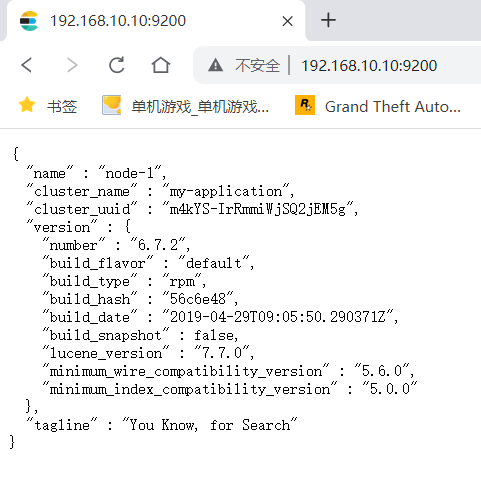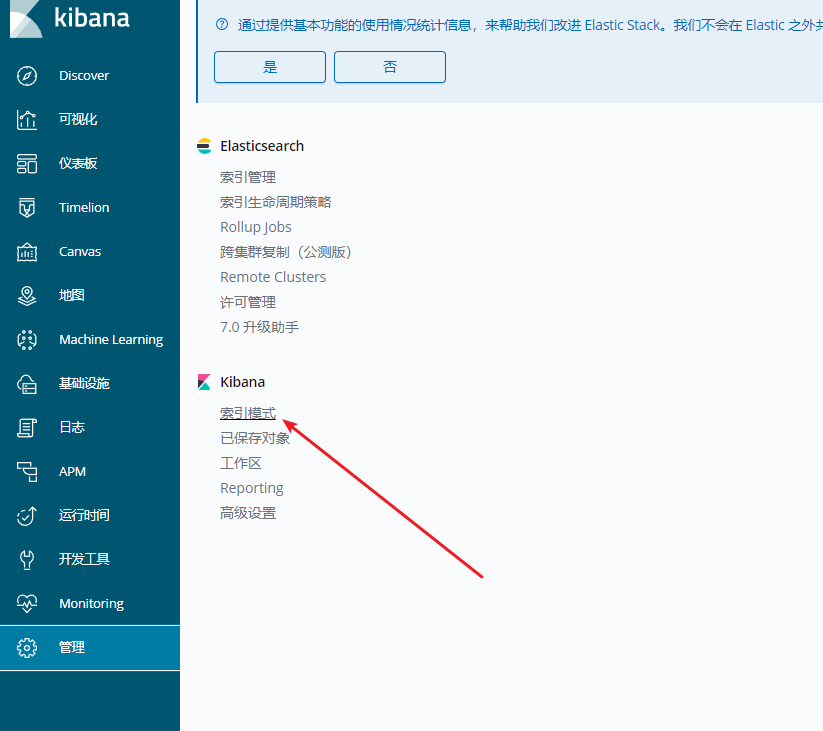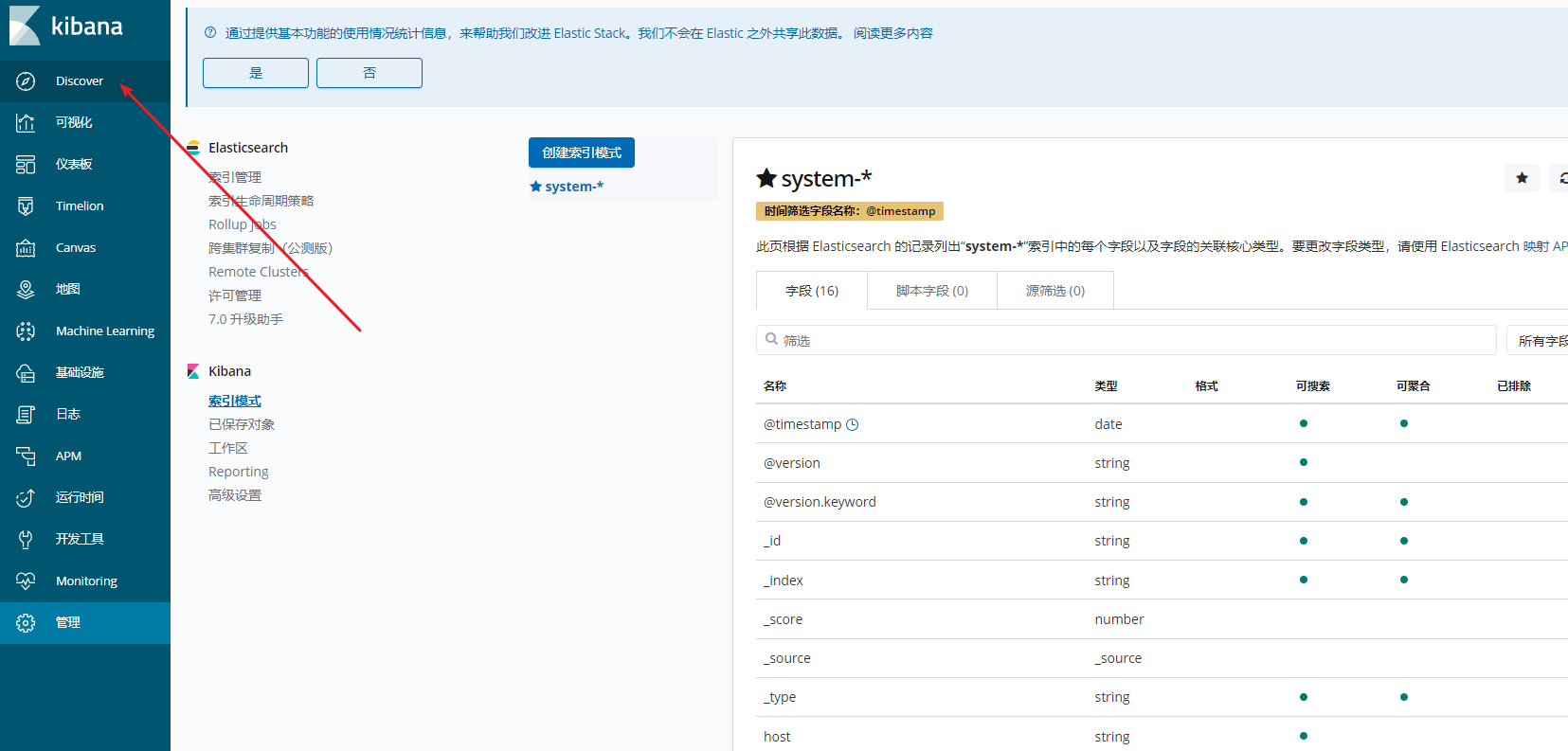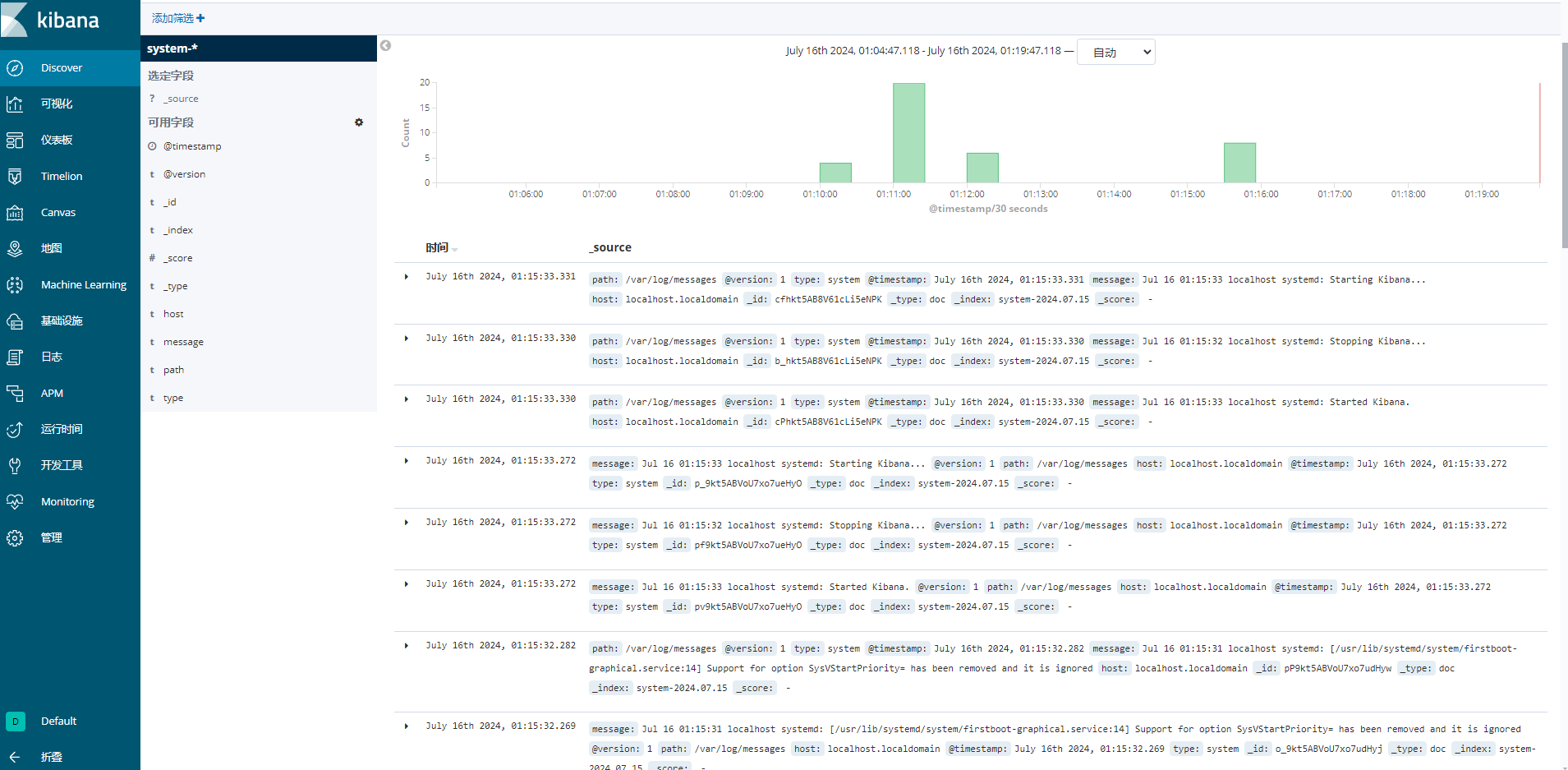ELK
ELK簡介
什麼是ELK
通俗來講,ELK 是由 Elasticsearch、Logstash、Kibana 三個開源軟體的組成的一個組合體,ELK 是 elastic 公司研發的一套完整的日誌收集、分析和展示的企業級解決方案,在這三個軟體當中,每個軟體用於完成不同的功能,ELK 又稱為ELK stack,官方域名為 elastic.co,ELK stack 的主要優點有如下幾個:處理方式靈活: elasticsearch 是實時全文索引,具有強大的搜尋功能配置相對簡單:elasticsearch 的 API 全部使用 JSON 介面,logstash 使用模組配置,kibana 的配置檔案部分更簡單。檢索效能高效:基於優秀的設計,雖然每次查詢都是實時,但是也可以達到百億級資料的查詢秒級響應。叢集線性擴充套件:elasticsearch 和 logstash 都可以靈活線性擴充套件前端操作絢麗:kibana 的前端設計比較絢麗,而且操作簡單
Elasticsearch
Elasticsearch是個開源分散式搜尋引擎,提供蒐集、分析、儲存資料三大功能。它的特點有:分散式,零配置,自動發現,索引自動分片,索引副本機制,restful風格介面,多資料來源,自動搜尋負載等。主要負責將日誌索引並儲存起來,方便業務方檢索查詢。
Elasticsearch 使用 Java 語言開發,是建立在全文搜尋引擎 Apache Lucene 基礎之上的搜尋引擎。
Elasticsearch 的特點:
- 實時搜尋、實時分析
- 分散式架構、實時檔案儲存
- 文件導向,所有物件都是文件
- 高可用,易擴充套件,支援叢集,分片與複製
- 介面友好,支援 json
Logstash
Logstash 主要是用來日誌的蒐集、分析、過濾日誌的工具,支援大量的資料獲取方式。一般工作方式為c/s架構,client端安裝在需要收集日誌的主機上,server端負責將收到的各節點日誌進行過濾、修改等操作在一併發往elasticsearch上去。是一個日誌收集、過濾、轉發的中介軟體,主要負責將各條業務線的各類日誌統一收集、過濾後,轉發給 Elasticsearch 進行下一步處理。
Kibana
Kibana 也是一個開源和免費的工具,Kibana可以為 Logstash 和 ElasticSearch 提供的日誌分析友好的 Web 介面,可以幫助彙總、分析和搜尋重要資料日誌。
ELK的工作原理
1.在所有需要收集日誌的伺服器上部署Logstash;或者先將日誌進行集中化管理在日誌伺服器上,在日誌伺服器上部署 Logstash。
2.Logstash 收集日誌,將日誌格式化並輸出到 Elasticsearch 群集中。
3.Elasticsearch 對格式化後的資料進行索引和儲存。
4.Kibana 從 ES 群集中查詢資料生成圖表,並進行前端資料的展示。
ELK安裝部署

前期準備
所以裝置
[root@localhost ~]# systemctl disable --now firewalld
[root@localhost ~]# setenforce 0
[root@localhost ~]# yum -y install java
[root@localhost ~]# hostnamectl set-hostname node1/node2/apache
#更改裝置名稱
安裝部署 Elasticsearch 軟體
安裝 Elasticsearch 軟體
#在軟體官網下載所需的安裝包到/data
[root@localhost data]# ls
elasticsearch-6.7.2.rpm elasticsearch-head-master.zip node-v8.2.1.tar.gz phantomjs-2.1.1-linux-x86_64.tar.bz2
#用rpm安裝Elasticsearch軟體
[root@localhost data]#rpm -ivh elasticsearch-6.7.2.rpm
[root@localhost data]# cd /etc/elasticsearch/
[root@localhost elasticsearch]# mkdir bak
[root@localhost elasticsearch]# cp -a *.yml bak/
#備份要修改的檔案,方便還原配置檔案
修改配置檔案
[root@node1 elasticsearch]# vim elasticsearch.yml
17 cluster.name: my-elk-cluster #修改叢集名字
23 node.name: node1 #設定節點名稱主從之間不能一致
24 node.master: true #作為主節點
25 node.data: true #作為資料節點
45 bootstrap.memory_lock: true #記憶體鎖開啟 禁止使用 swap
59 network.host: 0.0.0.0 #監聽地址
60 http.port: 9200 #預設使用埠
61 transport.tcp.port: 9300 #內部傳輸埠
73 discovery.zen.ping.unicast.hosts: ["192.168.10.10:9300", "192.168.10.20:9300"] #自動叢集發現,加入主機名 使用單播 類似心跳線
#再次檢視資料是否更改完成
[root@localhost elasticsearch]# grep -v "^#" elasticsearch.yml
cluster.name: my-elk-cluster
node.name: node1
node.master: true
node.data: true
path.data: /var/lib/elasticsearch
path.logs: /var/log/elasticsearch
bootstrap.memory_lock: true
network.host: 0.0.0.0
http.port: 9200
transport.tcp.port: 9300
discovery.zen.ping.unicast.hosts: ["192.168.10.10:9300", "192.168.10.20:9300"]
修改系統配置
效能調優引數
[root@localhost elasticsearch]# vim /etc/security/limits.conf
......
#在最後新增
* soft nofile 65536
* hard nofile 65536
* soft nproc 32000
* hard nproc 32000
* soft memlock unlimited
* hard memlock unlimited
修改systemd 服務管理器
/etc/systemd/system.conf 檔案是用於配置 systemd 的,這是一種用於 Linux 作業系統的系統和服務管理器。透過這個檔案,你可以自定義與系統操作、效能和行為相關的各種設定
- DefaultTimeoutStartSec=:設定啟動服務的預設等待時間
- DefaultTimeoutStopSec=:設定停止服務的預設等待時間
- DefaultRestartSec=:設定在重新啟動服務之前的預設休眠時間
- DefaultLimitNOFILE=:設定開啟檔案數量的預設限制
- DefaultLimitNPROC=:設定程序數量的預設限制
- DefaultLimitCORE=:設定核心檔案大小的預設限制
- DefaultEnvironment=:指定服務的預設環境變數
實際修改
[root@localhost elasticsearch]# vim /etc/systemd/system.conf
DefaultLimitNOFILE=65536
DefaultLimitNPROC=32000
DefaultLimitMEMLOCK=infinity
修改核心引數
[root@localhost elasticsearch]# vim /etc/sysctl.conf
#一個程序可以擁有的最大記憶體對映區域數,參考資料(分配 2g/262144,4g/4194304,8g/8388608)
vm.max_map_count=262144
[root@localhost elasticsearch]# sysctl -p #讀取並應用這些配置更改,無需重新啟動系統效。
[root@localhost elasticsearch]# sysctl -a | grep vm.max_map_count
重啟伺服器啟動elasticsearch
[root@localhost elasticsearch]# reboot #重啟伺服器
[root@localhost ~]# systemctl start elasticsearch.service #啟動elasticsearch
[root@localhost ~]# systemctl enable elasticsearch.service #設定開機啟動
[root@localhost ~]# ss -natp | grep 9200 #檢視埠號
檢視節點資訊
瀏覽器訪問
http://192.168.10.10:9200
http://192.168.10.20:9200
檢視節點 Node1、Node2 的資訊。

瀏覽器訪問
http://192.168.10.10:9200/_cluster/health?pretty
http://192.168.10.20:9200/_cluster/health?pretty
檢視群集的健康情況,可以看到 status 值為 green(綠色), 表示節點健康執行。
瀏覽器訪問 http://192.168.10.10:9200/_cluster/state?pretty 檢查群集狀態資訊
編譯安裝 Elasticsearch-head 外掛 主從都可以安裝
Elasticsearch 在 5.0 版本後,Elasticsearch-head 外掛需要作為獨立服務進行安裝,需要使用npm工具(NodeJS的包管理工具)安裝。
安裝 Elasticsearch-head 需要提前安裝好依賴軟體 node 和 phantomjs。
node:是一個基於 Chrome V8 引擎的 JavaScript 執行環境。
phantomjs:是一個基於 webkit 的JavaScriptAPI,可以理解為一個隱形的瀏覽器,任何基於 webkit 瀏覽器做的事情,它都可以做到。
編譯安裝node元件
[root@localhost ~]# yum install gcc gcc-c++ make -y
#下載安裝和解壓環境
[root@localhost ~]# cd /data/
[root@localhost data]# tar zxvf node-v8.2.1.tar.gz
[root@localhost data]# cd node-v8.2.1/
[root@localhost node-v8.2.1]# ./configure
[root@localhost node-v8.2.1]# make && make install
安裝 phantomjs
[root@localhost node-v8.2.1]# cd /data
[root@localhost data]# tar jxvf phantomjs-2.1.1-linux-x86_64.tar.bz2
[root@localhost data]# cd /data/phantomjs-2.1.1-linux-x86_64/bin
[root@localhost bin]# ln -s /opt/phantomjs-2.1.1-linux-x86_64/bin/phantomjs /usr/bin
安裝 Elasticsearch-head 資料視覺化工具
[root@localhost bin]# cd /data
[root@localhost data]# unzip elasticsearch-head-master.zip
[root@localhost data]# cd /data/elasticsearch-head-master/
[root@localhost elasticsearch-head-master]#npm install #安裝依賴包
[root@localhost elasticsearch-head-master]#npm install --registry=https://registry.npmmirror.com #指定源
修改 Elasticsearch 主配置檔案
[root@localhost elasticsearch-head-master]# vim /etc/elasticsearch/elasticsearch.yml
......
--末尾新增以下內容--
http.cors.enabled: true #開啟跨域訪問支援,預設為 false
http.cors.allow-origin: "*" #指定跨域訪問允許的域名地址為所有
[root@localhost elasticsearch-head-master]# systemctl restart elasticsearch
#重啟elasticsearch 服務
啟動 elasticsearch-head 服務
必須在解壓後的 elasticsearch-head 目錄下啟動服務,程序會讀取該目錄下的 gruntfile.js 檔案,否則可能啟動失敗。
[root@localhost elasticsearch-head-master]#cd /data/elasticsearch-head-master/
[root@localhost elasticsearch-head-master]# npm run start &
> elasticsearch-head@0.0.0 start /usr/local/src/elasticsearch-head
> grunt server
Running "connect:server" (connect) task
Waiting forever...
Started connect web server on http://localhost:9100
#elasticsearch-head 監聽的埠是 9100
[root@localhost elasticsearch-head-master]# ss -natp |grep 9100
#檢測9100 埠是否開啟
測試
網頁訪問:192.168.10.10:9100 或 192.168.10.20:9100

插入索引測試
[root@node2 elasticsearch-head-master]# curl -X PUT 'localhost:9200/index-demo/test/1?pretty&pretty' -H 'content-Type: application/json' -d '{"user":"zhangsan","mesg":"hello world"}'
{
"_index" : "index-demo",
"_type" : "test",
"_id" : "1",
"_version" : 1,
"result" : "created",
"_shards" : {
"total" : 2,
"successful" : 2,
"failed" : 0
},
"_seq_no" : 0,
"_primary_term" : 1
}

在應用伺服器部署 Logstash
安裝服務
[root@apache ~]# yum -y install java
[root@apache ~]# java -version
[root@apache ~]# yum -y install httpd
[root@apache ~]# systemctl start httpd
安裝logstash
[root@apache ~]# cd /data
[root@apache data]# ls
kibana-6.7.2-x86_64.rpm logstash-6.7.2.rpm
[root@apache data]# rpm -ivh logstash-6.7.2.rpm
#安裝logstash
[root@apache data]# systemctl enable --now logstash.service
#開啟logstash.service
[root@apache data]# ln -s /usr/share/logstash/bin/logstash /usr/bin/
# 做軟連線
使用logstash 收集日誌
Logstash 命令常用選項:
-f:透過這個選項可以指定 Logstash 的配置檔案,根據配置檔案配置 Logstash 的輸入和輸出流。
-e:從命令列中獲取,輸入、輸出後面跟著字串,該字串可以被當作 Logstash 的配置(如果是空,則預設使用 stdin 作為輸入,stdout 作為輸出)。
-t:測試配置檔案是否正確,然後退出。
[root@localhost opt]# logstash -e 'input { stdin{} } output { stdout{} }'
# 等待時間較長
WARNING: Could not find logstash.yml which is typically located in $LS_HOME/config or /etc/logstash. You can specify the path using --path.settings. Continuing using the defaults
Could not find log4j2 configuration at path /usr/share/logstash/config/log4j2.properties. Using default config which logs errors to the console
[INFO ] 2024-08-01 15:29:30.012 [main] writabledirectory - Creating directory {:setting=>"path.queue", :path=>"/usr/share/logstash/data/queue"}
[INFO ] 2024-08-01 15:29:30.031 [main] writabledirectory - Creating directory {:setting=>"path.dead_letter_queue", :path=>"/usr/share/logstash/data/dead_letter_queue"}
[WARN ] 2024-08-01 15:29:30.392 [LogStash::Runner] multilocal - Ignoring the 'pipelines.yml' file because modules or command line options are specified
[INFO ] 2024-08-01 15:29:30.399 [LogStash::Runner] runner - Starting Logstash {"logstash.version"=>"6.7.2"}
[INFO ] 2024-08-01 15:29:30.425 [LogStash::Runner] agent - No persistent UUID file found. Generating new UUID {:uuid=>"a499dafc-ae55-41da-b12d-36425108a95e", :path=>"/usr/share/logstash/data/uuid"}
[INFO ] 2024-08-01 15:29:35.985 [Converge PipelineAction::Create<main>] pipeline - Starting pipeline {:pipeline_id=>"main", "pipeline.workers"=>2, "pipeline.batch.size"=>125, "pipeline.batch.delay"=>50}
[INFO ] 2024-08-01 15:29:36.390 [Converge PipelineAction::Create<main>] pipeline - Pipeline started successfully {:pipeline_id=>"main", :thread=>"#<Thread:0x3a2c2f9e run>"}
The stdin plugin is now waiting for input:
[INFO ] 2024-08-01 15:29:36.458 [Ruby-0-Thread-1: /usr/share/logstash/lib/bootstrap/environment.rb:6] agent - Pipelines running {:count=>1, :running_pipelines=>[:main], :non_running_pipelines=>[]}
[INFO ] 2024-08-01 15:29:36.734 [Api Webserver] agent - Successfully started Logstash API endpoint {:port=>9600}
# 此處輸入需要的資訊
hello world
#############
/usr/share/logstash/vendor/bundle/jruby/2.5.0/gems/awesome_print-1.7.0/lib/awesome_print/formatters/base_formatter.rb:31: warning: constant ::Fixnum is deprecated
{
"message" => "hello world",
"host" => "localhost.localdomain",
"@version" => "1",
"@timestamp" => 2024-07-15T16:42:54.195Z
}
使用 Logstash 將資訊寫入 Elasticsearch 中
logstash -e 'input { stdin{} } output { elasticsearch { hosts=>["192.168.10.10:9200","192.168.10.20:9200"]} }'
//結果不在標準輸出顯示,而是傳送至 Elasticsearch 中,可瀏覽器訪問 http://192.168.10.10:9100/或http://192.168.10.20:9100 檢視索引資訊和資料瀏覽。
使用配置檔案
Logstash 配置檔案基本由三部分組成:input、output 以及 filter(可選,根據需要選擇使用)
-
input:表示從資料來源採集資料,常見的資料來源如Kafka、日誌檔案等
file beats kafka redis stdin -
filter:表示資料處理層,包括對資料進行格式化處理、資料型別轉換、資料過濾等,支援正規表示式
grok 對若干個大文字欄位進行再分割成一些小欄位 (?<欄位名>正規表示式) 欄位名: 正規表示式匹配到的內容
date 對資料中的時間格式進行統一和格式化
mutate 對一些無用的欄位進行剔除,或增加欄位
mutiline 對多行資料進行統一編排,多行合併或拆分 -
output:表示將Logstash收集的資料經由過濾器處理之後輸出到Elasticsearch。
elasticsearch stdout
#格式如下:
input {...}
filter {...}
output {...}
#在每個部分中,也可以指定多個訪問方式。例如,若要指定兩個日誌來原始檔,則格式如下:
input {
file { path =>"/var/log/messages" type =>"syslog"}
file { path =>"/var/log/httpd/access.log" type =>"apache"}
vim system.conf
input {
file{
path =>"/var/log/messages"
type =>"system"
start_position =>"beginning"
# ignore_older => 604800
sincedb_path => "/etc/logstash/sincedb_path/log_progress"
add_field => {"log_hostname"=>"${HOSTNAME}"}
}
}
#path表示要收集的日誌的檔案位置
#type是輸入ES時給結果增加一個叫type的屬性欄位
#start_position可以設定為beginning或者end,beginning表示從頭開始讀取檔案,end表示讀取最新的,這個要和ignore_older一起使用
#ignore_older表示了針對多久的檔案進行監控,預設一天,單位為秒,可以自己定製,比如預設只讀取一天內被修改的檔案
#sincedb_path表示檔案讀取進度的記錄,每行表示一個檔案,每行有兩個數字,第一個表示檔案的inode,第二個表示檔案讀取到的位置(byteoffset)。預設為$HOME/.sincedb*
#add_field增加屬性。這裡使用了${HOSTNAME},即本機的環境變數,如果要使用本機的環境變數,那麼需要在啟動命令上加--alow-env
output {
elasticsearch { #輸出到 elasticsearch
hosts => ["192.168.91.100:9200","192.168.91.101:9200"] #指定 elasticsearch 伺服器的地址和埠
index =>"system-%{+YYYY.MM.dd}" #指定輸出到 elasticsearch 的索引格式
}
}
實列
[root@apache log]# vim /etc/logstash/conf.d/system-log.conf
input {
file {
path => "/var/log/messages"
type => "system"
start_position => "beginning"
}
file {
path => "/var/log/yum.log"
type => "yum"
start_position => "beginning"
}
}
output {
if type]
elasticsearch {
hosts => [ "192.168.91.100:9200","192.168.91.101:9200" ]
index => "system-%{+YYYY.MM.dd}"
}
}
[root@apache conf.d]# chmod +r /var/log/messages
#新增許可權
[root@apache conf.d]# logstash -f system-log.conf
#啟動logstash
........................................................................
[INFO ] 2024-07-16 01:02:41.716 [Api Webserver] agent - Successfully started Logstash API endpoint {:port=>9601}
安裝 kibana 無所謂哪臺伺服器
安裝
[root@apache log]# cd /data/
[root@apache data]# rpm -ivh kibana-6.7.2-x86_64.rpm
修改配置
[root@apache data]# cd /etc/kibana/
[root@localhost kibana]# cp kibana.yml kibana.yml.bak -a
# 做好主要配置檔案的備份
[root@apache kibana]# vim kibana.yml
# 修改以下行
2 server.port: 5601 #開啟埠
7 server.host: "0.0.0.0" #監聽埠
28 elasticsearch.hosts: ["http://192.168.91.100:9200", "http://192.168.91.101:9200"] #el伺服器地址
37 kibana.index: ".kibana" #開啟索引
96 logging.dest: /var/log/k.log #指定日誌檔案, 需要手動建立檔案
114 i18n.locale: "zh-CN" #中文設定
[root@apache kibana]# chown kibana:kibana /var/log/k.log
啟動 kibana
[root@apache kibana]# systemctl enable --now kibana.service
[root@apache kibana]# ss -nap |grep 5601
tcp LISTEN 0 128 *:5601 *:* users:(("node",pid=42235,fd=19))
訪問測試
192.168.10.30:5601










